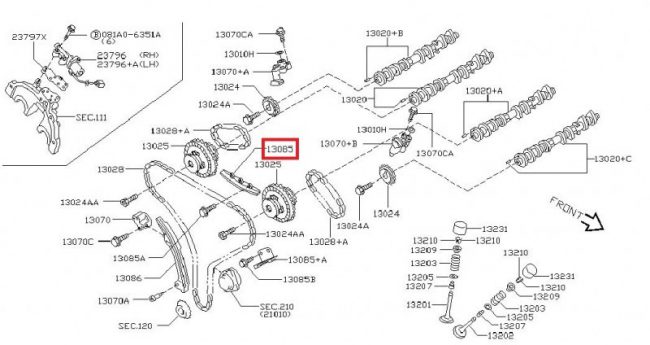
Nissan vq23de engine
Content
The Nissan VQ23DE power unit is one of Nissan's six-cylinder V-engines. The VQ engine series differs from its predecessors in a cast aluminum block and a twin-camshaft cylinder head.
The design of the engine is made in such a way that the angle between the pistons is 60 degrees. For a long time now, the VQ engine line-up has been named one of the best powertrains by Ward's AutoWorld magazine every year. The VQ series replaced the VG engine line.
The history of the creation of the VQ23DE motor
Nissan in 1994 planned to give birth to a generation of executive sedans. The company's employees set themselves the goal, among other things, to develop a completely new engine that will be distinguished by good power performance and a high degree of reliability.  The decision was made to take the previous generation of VG engines as the basis for such a power unit, because their V-shaped design had great potential for further upgrades. The developers only had to take into account the experience of using and repairing the previous line of engines.
The decision was made to take the previous generation of VG engines as the basis for such a power unit, because their V-shaped design had great potential for further upgrades. The developers only had to take into account the experience of using and repairing the previous line of engines.
For reference! Between the VG and VQ series, there is a transitional version of the VE30DE (on the bottom photo), which included a cylinder block from the VG model, and intake and exhaust manifolds, a gas distribution mechanism and other design features from the VQ series!
Along with the VQ20DE, VQ25DE and VQ30DE, the VQ23DE has become one of the most beloved engines in the new Teana business sedan. Since the VQ series engines were developed exclusively for a premium car, a V-shaped six-cylinder design suggested itself. However, with a cast-iron block, the power unit was too heavy, so the designers decided to make it from an aluminum alloy, which greatly facilitated the motor.
The gas distribution mechanism has also undergone changes. Instead of a belt drive, which was distinguished by a small operational resource (about 100 thousand km), they began to use a chain drive. It is worth noting that this did not affect the noise of the engine in any way, since modern chain mechanisms were used. Judging by user reviews, the timing chain system (in the bottom photo) is ready to serve more than 400 thousand km without intervention.
The next innovation was the rejection of hydraulic lifters. This decision was due to the fact that in the countries where most cars were exported, they used mostly low-quality mineral motor oil. All this led to a quick failure of the hydraulic lifters on the power units of the VG series. The dual camshaft system was adopted because the designers decided to use two intake and exhaust valves per cylinder. In addition, the engine was endowed with a distributive fuel injection system.
Engine Specifications VQ23DE
All technical parameters of this power unit are summarized in the following table:
| Features | Parameters |
|---|---|
| ICE index | VQ23DE |
| Volume, cm 3 | 2349 |
| Power, HP | 173 |
| Torque, N * m | 225 |
| fuel type | AI-92, AI-95 |
| Fuel consumption, l / 100 km | 8-9 |
| Engine information | Petrol, V-6, 24-valve, DOHC, Distribution Fuel Injection |
| Cylinder diameter, mm | 85 |
| The piston stroke, mm | 69 |
| Compression ratio | 10 |
| ICE number location | On the block of cylinders (on the platform on the right) |
Nuances in the operation of the VQ23DE engine and its disadvantages
The main feature of this power unit is the absence of hydraulic lifters, therefore it is recommended to adjust the valves every 100 thousand kilometers. In addition, a new type of ignition coils, an electronic throttle valve were introduced into this engine, the cylinder head was improved, balancing shafts and a variable valve timing system were added.
The most popular malfunctions of the VQ23DE power unit are:
- Stretching the timing chain. This malfunction is more characteristic of the first versions of this engine. The car starts to twitch, and the idle floats. Replacing the chain in completely solves the problem;
- Oil leak from under the valve cover. The elimination of the leak is solved by replacing the gasket;
- Increased oil consumption due to worn piston rings;
- Engine vibrations. This malfunction is eliminated by flashing the motor. Spark plugs can also cause this.
The disadvantages of this power unit can also include a problematic start in cold weather (over -20 degrees). The catalytic converter and thermostat differ in fragility. On average, a major overhaul of the VQ23DE internal combustion engine is carried out after 250 - 300 thousand kilometers. To achieve such a resource, you should use high-quality engine oil with a viscosity of 0W-30 to 20W-20. It is recommended to replace it every 7 - 500 km. In general, this engine has good maintainability, everything changes in detail.
For reference! If fuel consumption has increased sharply and an increased level of exhaust gases is observed, then you should pay attention to the oxygen sensor!
Vehicles with VQ23DE engines
The list of cars that were equipped with VQ23DE power plants is as follows:
| Engine index | Car |
|---|---|
| VQ23DE | Nissan Teana |

